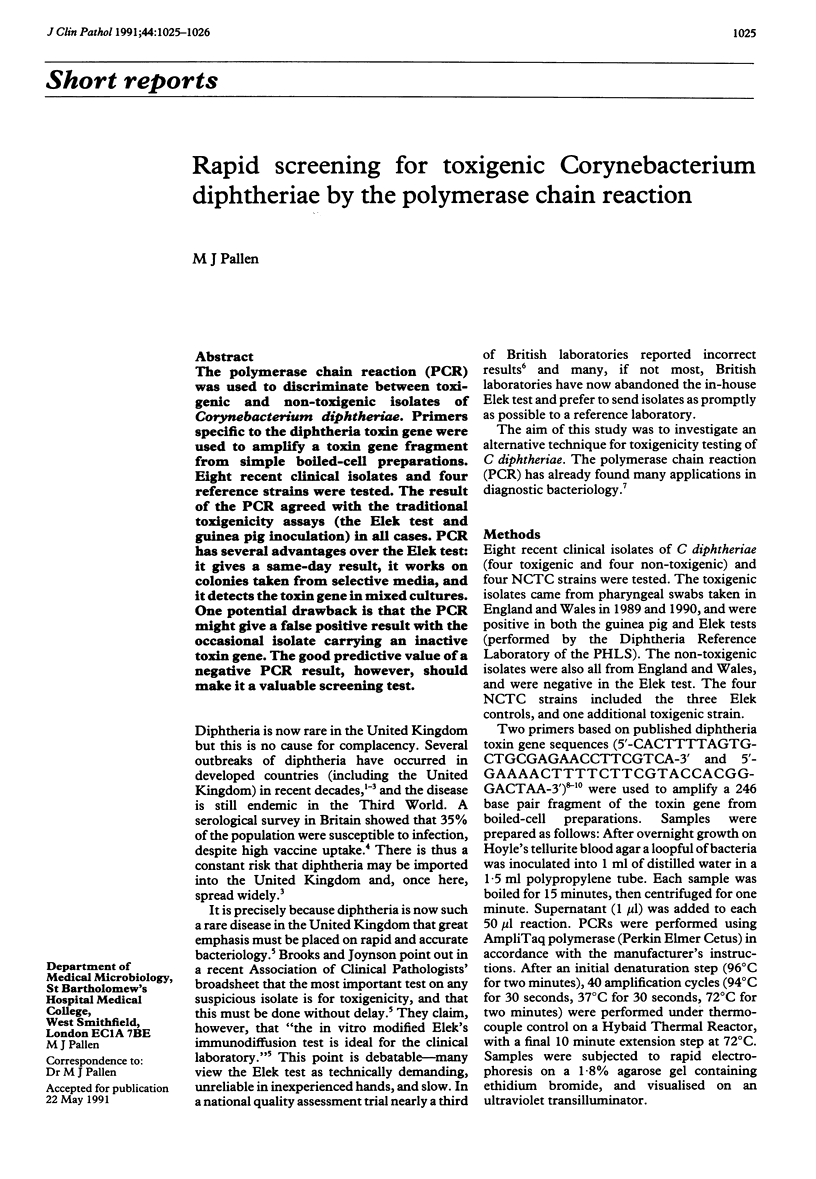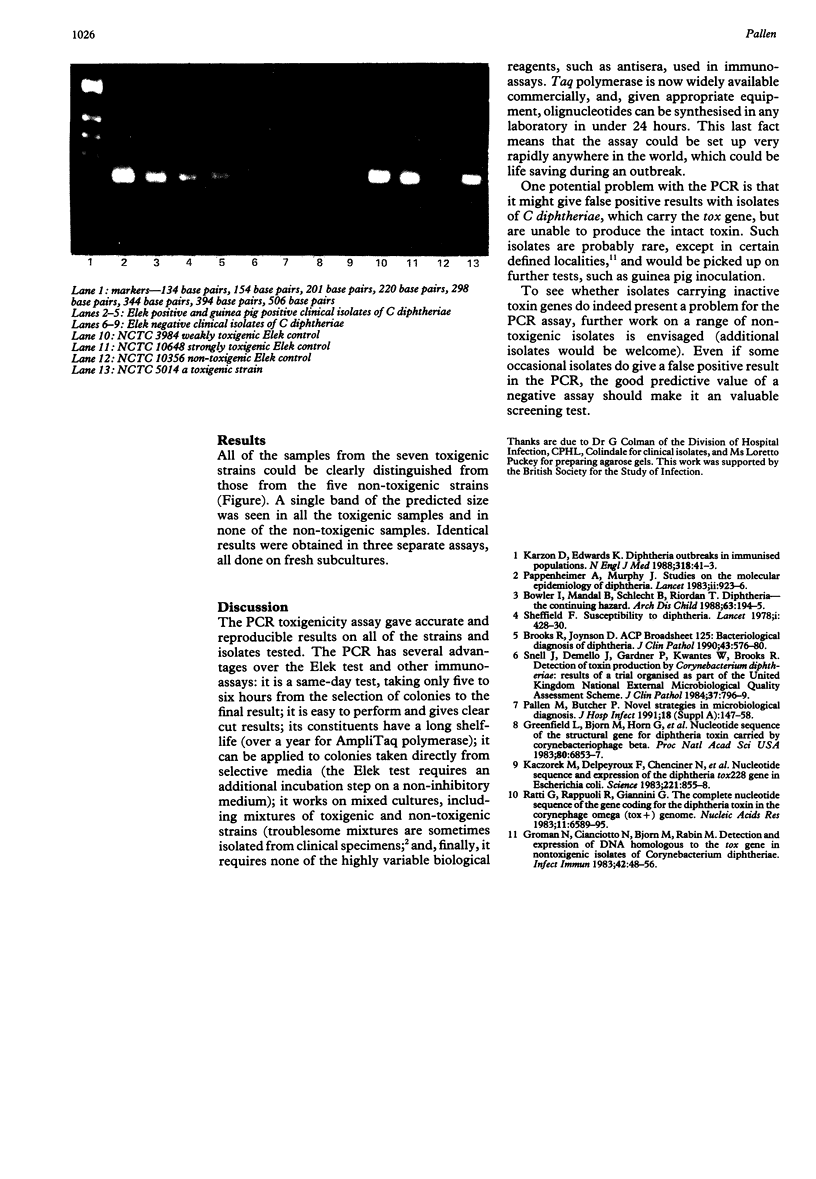Abstract
The polymerase chain reaction (PCR) was used to discriminate between toxigenic and non-toxigenic isolates of Corynebacterium diphtheriae. Primers specific to the diphtheria toxin gene were used to amplify a toxin gene fragment from simple boiled-cell preparations. Eight recent clinical isolates and four reference strains were tested. The result of the PCR agreed with the traditional toxigenicity assays (the Elek test and guinea pig inoculation) in all cases. PCR has several advantages over the Elek test: it gives a same-day result, it works on colonies taken from selective media, and it detects the toxin gene in mixed cultures. One potential drawback is that the PCR might give a false positive result with the occasional isolate carrying an inactive toxin gene. The good predictive value of a negative PCR result, however, should make it a valuable screening test.
Full text
PDF

Images in this article
Selected References
These references are in PubMed. This may not be the complete list of references from this article.
- Bowler I. C., Mandal B. K., Schlecht B., Riordan T. Diphtheria--the continuing hazard. Arch Dis Child. 1988 Feb;63(2):194–195. doi: 10.1136/adc.63.2.194. [DOI] [PMC free article] [PubMed] [Google Scholar]
- Brooks R., Joynson D. H. ACP Broadsheet no 125: July 1990. Bacteriological diagnosis of diphtheria. J Clin Pathol. 1990 Jul;43(7):576–580. doi: 10.1136/jcp.43.7.576. [DOI] [PMC free article] [PubMed] [Google Scholar]
- Dadswell J. V. Susceptibility to diphtheria. Lancet. 1978 Feb 25;1(8061):428–430. [PubMed] [Google Scholar]
- Greenfield L., Bjorn M. J., Horn G., Fong D., Buck G. A., Collier R. J., Kaplan D. A. Nucleotide sequence of the structural gene for diphtheria toxin carried by corynebacteriophage beta. Proc Natl Acad Sci U S A. 1983 Nov;80(22):6853–6857. doi: 10.1073/pnas.80.22.6853. [DOI] [PMC free article] [PubMed] [Google Scholar]
- Groman N., Cianciotto N., Bjorn M., Rabin M. Detection and expression of DNA homologous to the tox gene in nontoxinogenic isolates of Corynebacterium diphtheriae. Infect Immun. 1983 Oct;42(1):48–56. doi: 10.1128/iai.42.1.48-56.1983. [DOI] [PMC free article] [PubMed] [Google Scholar]
- Kaczorek M., Delpeyroux F., Chenciner N., Streeck R. E., Murphy J. R., Boquet P., Tiollais P. Nucleotide sequence and expression of the diphtheria tox228 gene in Escherichia coli. Science. 1983 Aug 26;221(4613):855–858. doi: 10.1126/science.6348945. [DOI] [PubMed] [Google Scholar]
- Karzon D. T., Edwards K. M. Diphtheria outbreaks in immunized populations. N Engl J Med. 1988 Jan 7;318(1):41–43. doi: 10.1056/NEJM198801073180108. [DOI] [PubMed] [Google Scholar]
- Pallen M. J., Butcher P. D. New strategies in microbiological diagnosis. J Hosp Infect. 1991 Jun;18 (Suppl A):147–158. doi: 10.1016/0195-6701(91)90017-3. [DOI] [PubMed] [Google Scholar]
- Pappenheimer A. M., Jr, Murphy J. R. Studies on the molecular epidemiology of diphtheria. Lancet. 1983 Oct 22;2(8356):923–926. doi: 10.1016/s0140-6736(83)90449-x. [DOI] [PubMed] [Google Scholar]
- Ratti G., Rappuoli R., Giannini G. The complete nucleotide sequence of the gene coding for diphtheria toxin in the corynephage omega (tox+) genome. Nucleic Acids Res. 1983 Oct 11;11(19):6589–6595. doi: 10.1093/nar/11.19.6589. [DOI] [PMC free article] [PubMed] [Google Scholar]
- Snell J. J., Demello J. V., Gardner P. S., Kwantes W., Brooks R. Detection of toxin production by Corynebacterium diphtheriae: results of a trial organised as part of the United Kingdom National External Microbiological Quality Assessment Scheme. J Clin Pathol. 1984 Jul;37(7):796–799. doi: 10.1136/jcp.37.7.796. [DOI] [PMC free article] [PubMed] [Google Scholar]



